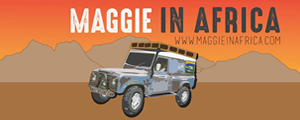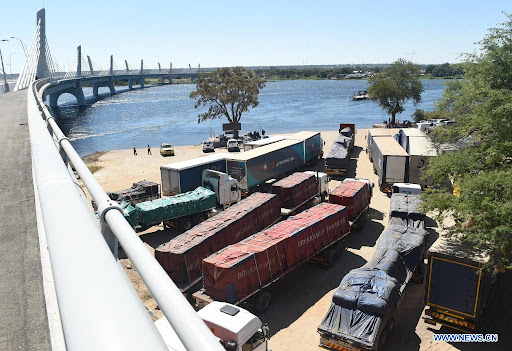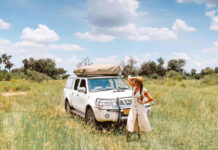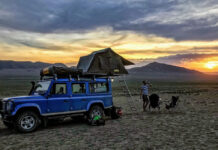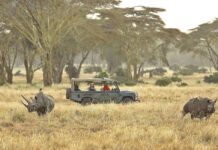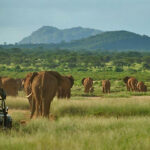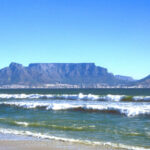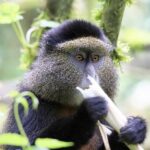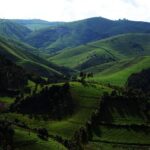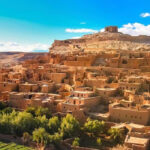The Kazungula border from Botswana to Zambia is a bit of a hassle compared to other borders in Southern Africa. Two hours in the baking heat, a few hoops and US$300 later, we finally entered Zambia…
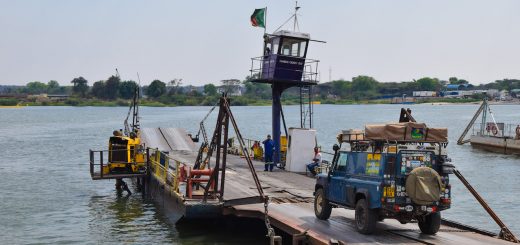 Kazungula ferry border crossing
Kazungula ferry border crossing
Botswana and Zambia share the world’s shortest border crossing (depending on who you ask) – just 750 metres in the the Zambezi river. It is in this spot where the corners of four countries meet – Namibia, Botswana, Zambia and Zimbabwe. So, of course, what overland trip would be complete with crossing this epic border?
The only way to cross the Kazungula border is by ferry. On approaching the border from the Botswana side, there is a miles-long queue of lorries waiting to cross via one of a few small ferries, which can only hold two large lorries at a time. Some drivers wait here for days to cross…
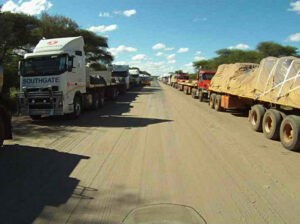
Queues of lorries waiting to cross the Kazungula ferry…
Thankfully, smaller, non-commercial vehicles have priority, so we zipped to the head of the queue. We had only a minimal waiting time to get onto the ferry to be chugged across four international borders to Zambia.
To cross on the ferry, operators charge $30, P200 or K150.
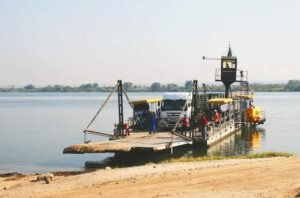
Maggie boarding the Kazungula ferry
Border crossing requirements
The paperwork and process on the Botswana side was a piece of cake – hardly any queue to have our passports stamped for exit, and to get a temporary export permit for our Botswana-registered vehicle. However, on the Zambian side, things got a bit more difficult…
When approaching the border, anyone looking remotely like a tourist will be approached by one of the many Zambian ‘fixers’ persistently offering help. We tried to resist, but eventually gave in. The process on the Zambian side is confusing, spread out among multiple buildings, with few obvious instructions. And at least two of the fees (council and carbon tax) must be paid in cash in Kwacha, which is hard to get outside of Zambia.
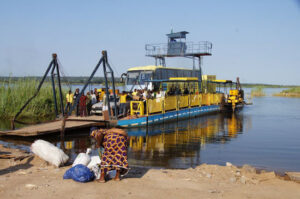
Our fixer on the Kazungula ferry border crossing
Our tips: make sure to negotiate a fee upfront with the fixer. Ours asked for US$5, which we thought was too low for two hours of his time, so we later gave him US$10. Don’t pay until you’re finished. The fixers will ‘loan’ Zambian Kwacha to pay for some of the fees, and you can reimburse them later in USD. But make sure to note a fair exchange rate (approx. $1 to K10 at time of writing).
Visa on arrival
On the Zambian side, the first stop is Immigration, where those holding UK or US passports can pay US$50 for single entry visa (valid for 30 days) or $80 for a double entry visa (valid for 90 days). At the time of writing, it’s necessary to exit Zambia to see Victoria falls from Zimbabwe, so we recommend a double entry visa for those who would like to do so. Also, make sure to have a Zambian address or the name of a lodge or campsite handy, because officials will ask where you are going to stay.
Crossing with a car
On the Botswana side, there was no fee for exiting with our Botswana-registered vehicle. However, on the Zambian side, there were many fees.
Customs
At the counter next to immigration, we presented custom officials with our ownership documents and carnet de passage. The officer checked that the ownership documents and passport were in the same name, and was giving hassle to those whose documents were in different names, so make sure you have a letter of permission if the vehicle is in another name / owned by someone else (i.e., a rental).
After a few stamps and signatures on our carnet, we were told ‘things would be so much harder if you didn’t have this!’ But all we could ascertain was that they would need to issue a Temporary Import Permit, which may or may not have carried a fee but certainly looked like a hassle…
Road tax
Moving on from customs, we paid a $48 road tax fee for Botswana-registered vehicles. This was the highest fee payable (thanks, Zambia). Vehicles registered in other countries, such as South Africa, attract smaller road taxes (just $20). We were able to pay with USD, and received change. We were asked to present our ownership documents, passport and carnet de passage.
Carbon tax
Depending on the size of your engine, you will be asked to pay carbon tax. With a 2,499 CC engine, we were asked to pay K150 ($15). You cannot pay this fee in USD; it must be paid in Zambian Kwacha.
Third party insurance
Surprise, surprise, most fixers are double agents. Ours was also an agent for a third party insurance provider, with an office just outside the border gates. Unfortunately, our Botswana liability insurance only covers damage in Zambia, not third party. So we paid about K300 ($30) for three months of third party insurance, proof of which was stuck to our windscreen, and later checked by police at many road blocks.
Council tax
Finally, we were asked to pay a K60 (US$6) fee to in tax to the local council. We still have no idea why, but there are many billboards threatening fines of up to $2,000 for avoiding this crucial tax.
Where to camp
Overall, the border crossing takes one to two hours. In the baking October heat, this feels like two years. So we recommend staying overnight in Kasane or Kazungula in Botswana and crossing in the early morning when it’s cooler and your mood is at its best. From the Zambian side, it is approx. 75 km to Livingstone, the next major town in Zambia, on a road with wildlife, so driving at night should be avoided.
In Botswana, we camped at the Toro Big Five Lodge, just 1km from the border and also within easy distance of the Chobe National Park. In Zambia, we camped at the Maramba River Lodge, just a few km away from the amazing Victoria falls.
